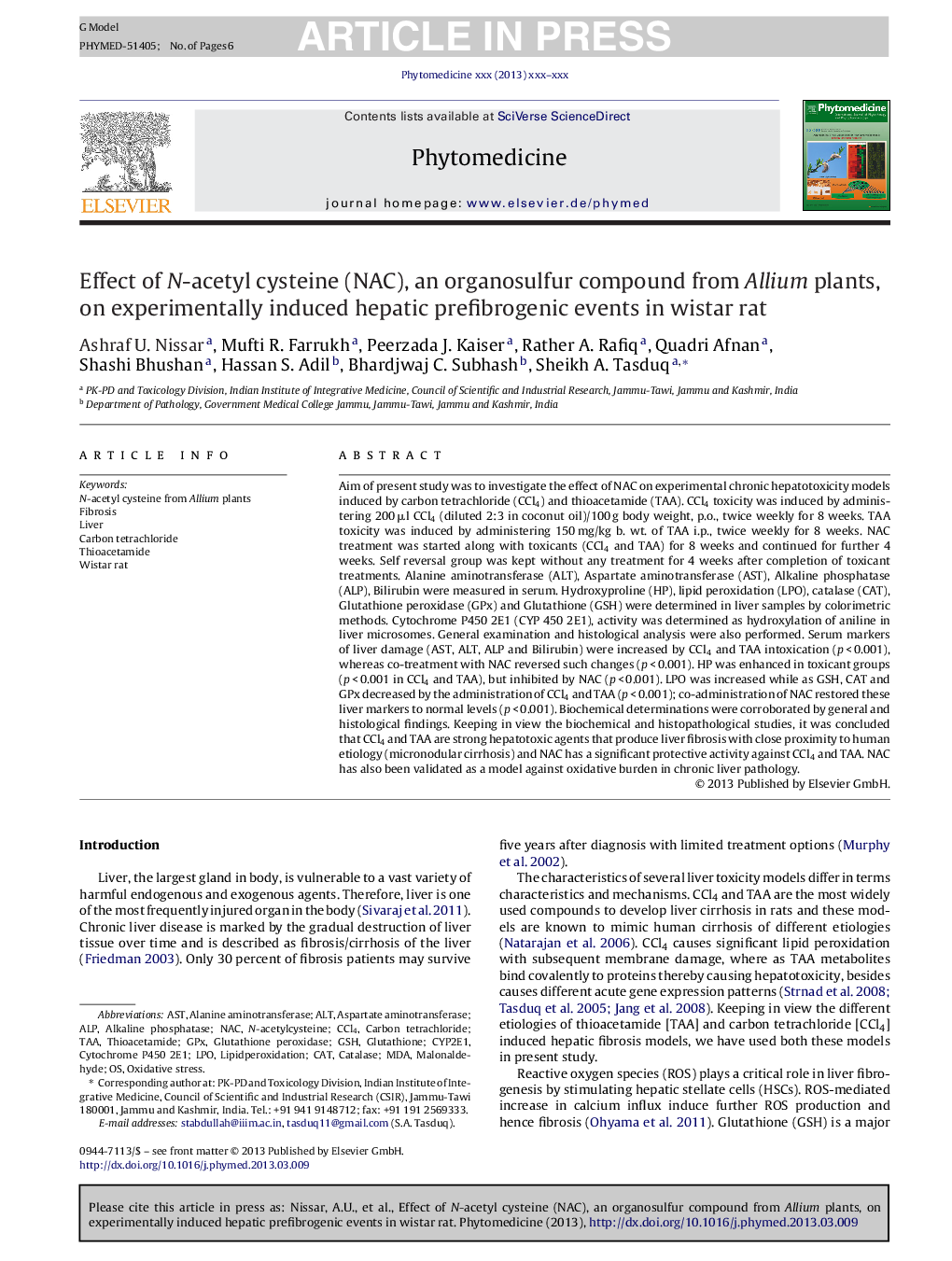| کد مقاله | کد نشریه | سال انتشار | مقاله انگلیسی | نسخه تمام متن |
|---|---|---|---|---|
| 5816695 | 1116154 | 2013 | 6 صفحه PDF | دانلود رایگان |
عنوان انگلیسی مقاله ISI
Effect of N-acetyl cysteine (NAC), an organosulfur compound from Allium plants, on experimentally induced hepatic prefibrogenic events in wistar rat
دانلود مقاله + سفارش ترجمه
دانلود مقاله ISI انگلیسی
رایگان برای ایرانیان
کلمات کلیدی
TAAMDACYP2E1CATCCl4GSHNACGPXALTLPON-acetylcysteine - N-استیل سیستئینAST - آسپارتات ترانس آمینازAspartate aminotransferase - آسپارتات ترانس آمیناز یا AST Alanine aminotransferase - آلانین آمینوترانسفرازALP - آلکالن فسفاتازAlkaline phosphatase - آلکالین فسفاتاز یا فسفاتاز قلیاییOxidative stress - تنش اکسیداتیوThioacetamide - تیوات آمیدcytochrome P450 2E1 - سیتوکروم P450 2E1Fibrosis - فیبروز یا فساد الیافLipidperoxidation - لیپید پراکسیداسیونmalonaldehyde - مالونالدئیدWistar rat - موش ویستارCatalase - کاتالازLiver - کبدCarbon tetrachloride - کربن تتراکلریدGlutathione - گلوتاتیونglutathione peroxidase - گلوتاتیون پراکسیداز
موضوعات مرتبط
علوم زیستی و بیوفناوری
بیوشیمی، ژنتیک و زیست شناسی مولکولی
بیوشیمی بالینی
پیش نمایش صفحه اول مقاله

چکیده انگلیسی
Aim of present study was to investigate the effect of NAC on experimental chronic hepatotoxicity models induced by carbon tetrachloride (CCl4) and thioacetamide (TAA). CCl4 toxicity was induced by administering 200 μl CCl4 (diluted 2:3 in coconut oil)/100 g body weight, p.o., twice weekly for 8 weeks. TAA toxicity was induced by administering 150 mg/kg b. wt. of TAA i.p., twice weekly for 8 weeks. NAC treatment was started along with toxicants (CCl4 and TAA) for 8 weeks and continued for further 4 weeks. Self reversal group was kept without any treatment for 4 weeks after completion of toxicant treatments. Alanine aminotransferase (ALT), Aspartate aminotransferase (AST), Alkaline phosphatase (ALP), Bilirubin were measured in serum. Hydroxyproline (HP), lipid peroxidation (LPO), catalase (CAT), Glutathione peroxidase (GPx) and Glutathione (GSH) were determined in liver samples by colorimetric methods. Cytochrome P450 2E1 (CYP 450 2E1), activity was determined as hydroxylation of aniline in liver microsomes. General examination and histological analysis were also performed. Serum markers of liver damage (AST, ALT, ALP and Bilirubin) were increased by CCl4 and TAA intoxication (p < 0.001), whereas co-treatment with NAC reversed such changes (p < 0.001). HP was enhanced in toxicant groups (p < 0.001 in CCl4 and TAA), but inhibited by NAC (p < 0.001). LPO was increased while as GSH, CAT and GPx decreased by the administration of CCl4 and TAA (p < 0.001); co-administration of NAC restored these liver markers to normal levels (p < 0.001). Biochemical determinations were corroborated by general and histological findings. Keeping in view the biochemical and histopathological studies, it was concluded that CCl4 and TAA are strong hepatotoxic agents that produce liver fibrosis with close proximity to human etiology (micronodular cirrhosis) and NAC has a significant protective activity against CCl4 and TAA. NAC has also been validated as a model against oxidative burden in chronic liver pathology.
ناشر
Database: Elsevier - ScienceDirect (ساینس دایرکت)
Journal: Phytomedicine - Volume 20, Issue 10, 15 July 2013, Pages 828-833
Journal: Phytomedicine - Volume 20, Issue 10, 15 July 2013, Pages 828-833
نویسندگان
Ashraf U. Nissar, Mufti R. Farrukh, Peerzada J. Kaiser, Rather A. Rafiq, Quadri Afnan, Shashi Bhushan, Hassan S. Adil, Bhardjwaj C. Subhash, Sheikh A. Tasduq,